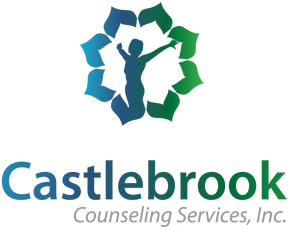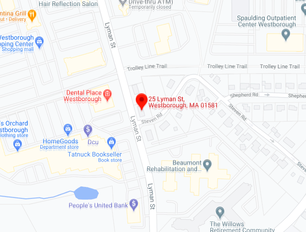Clinician Spotlight: An Interview with Kaitlyn Hall, LMHCBy Lauren Chapin, LICSW
Welcome to Castlebrook’s Clinician Spotlight series where I sit down with some of our wonderful therapists for a cozy conversation about work, mental health, and many life tidbits in between! This month, I had the opportunity to get to know Kaitlyn Hall, LMHC who has been a therapist at Castlebrook since 2021. Kaitlyn and I discussed her journey to private practice, her love of research, and her favorite hobby outside of work (which may surprise you!). Lauren: Hi Kaitlyn! Welcome back to the office! Let’s get started with some background on your experience. How long have you been with Castlebrook now? Kaitlyn: I reached out to Kerrie (Executive Director) right after I got licensed in October 2020 and was working in the office by January 2021. So this January, it will be three years! Lauren: What was it about Castlebrook that initially drew you to the practice? Kaitlyn: Well, I met Kerrie while I was in graduate school, actually. I went to Becker College (before it closed) and they had a brand new Masters in Counseling program with a concentration in DBT. The other option was school counseling, and since I knew that I didn’t want to work in a school, I picked the DBT program, and it ended up working out excellently. I had the opportunity to shadow a couple of Kerrie’s groups during my first year and I just thought, “Who is this rockstar? How does she get people to participate and actually enjoy it?” Then in my second year, I had the chance to co-lead with Kerrie and really got to know the DBT curriculum. I emailed her after graduation once I was independently licensed and here we are! Lauren: Is DBT still a main focus of yours? Kaitlyn: Yes. I’ve been trying to make DBT work for my clients, if that makes sense. I still practice full protocol DBT to fidelity as instructed by Marsha Linehan, but I also like to adapt it. I have speciality training in treating individuals with eating disorders and there has been so much evidence that shows DBT can really benefit somebody with an eating disorder. Also, with athletes, there’s research coming to light now about the mental health issues and pressures that competitive and elite athletes face, and I've been trying to see how I can use DBT for that population as well. I try not to force it on any clients, but it’s so easily adaptable that I can kind of sprinkle it in there. Lauren: What parts of DBT have you found are helpful for folks who are experiencing eating disorders? Kaitlyn: Definitely the mindfulness piece. As the foundation of DBT, everybody could benefit from being more mindful in their daily life. With an eating disorder, so many things take you out of the present moment. One intervention the eating disorder community uses with clients is trying to externalize the eating disorder. You give it a name, give it a voice, and it’s something separate from yourself. I think mindfulness can really help us do that in order to not only stay present, but to have this separate entity that’s not us; we’re not defined by it. Other applications are to utilize emotional regulation and distress tolerance while trying to decrease/reduce eating disorder behaviors. It’s incredibly stressful for the client and these foundational interventions come in handy with that! Lauren: I wonder, when it comes to athletes, are they primed to be receptive to mindfulness because of how singularly focused they need to be during a game? Kaitlyn: Oh yeah. Well, I think mindfulness is a great reminder for them to not only stay in the game, but stay out of it when they need to step away. I was just reading an article about how mindfulness helps with both their performance and the recovery after, mentally and physically. It emphasized the mind-body connection, trying to avoid injury, and healing. I find it so cool, I’m a huge research nerd. I love learning about new things that are coming out in the field. Lauren: Tell me more about the research with athletes! Kaitlyn: I keep coming back to it. They did an excellent job making the connection between athletes and DBT. They broke it down by DBT modules: mindfulness, emotional regulation, distress tolerance, and interpersonal effectiveness. Then, they went through each of those sections and discussed where it could be applied to athletes and their experiences, almost like a manual. Lauren: So you use DBT with different populations, you work with folks experiencing eating disorders, what else do you fold into your practice? Kaitlyn: I try to fold in creative outlets. I originally got my bachelor’s in liberal arts, super basic, because I had a feeling that I was going to go into kind of an eclectic counseling practice. I actually went to the Pratt Institute in Brooklyn for creative arts therapy where I studied for about a year before deciding to come back to Massachusetts to finish with a masters in counseling. I learned so many valuable therapeutic interventions during that year using art and movement. I try to utilize that as much as possible, especially combined with mindfulness. There are many clients that come in and say, “I don’t want to do deep breathing,” and you have to say, “Well, A., deep breathing is great [laughs], and B., we can do so many other things that are mindful that have nothing to do with breath work!” I find that art is one way to do that. Lauren: You’ve talked about the population you normally work with, can you share a bit more? Kaitlyn: I predominantly work with adults, but sometimes will make an exception depending on what’s going on with a referral I might get for a kiddo. I do enjoy a lot of the young adult work and the transition into adulthood/coming of age stuff that happens that nobody prepares us for. The second puberty; we all went through it, nobody really helps us with it. I’ve also had a lot of clients with ADHD, or suspecting they might have it. That’s ending up being a commonality with a lot of my young adults. Lauren: It sounds like you work with some clients who are especially emotionally vulnerable. How do you try to foster a safe, non-judgmental space around that? Kaitlyn: I try to have as much of a “no-pressure” approach as possible. I do point out that sometimes [therapy] can be weird, unique, and also quite difficult. I let them know that I’m on their team and the nonjudgmental stance that DBT really strives for right at the beginning is trying to constantly remind them of that. It could take a year for someone to really buy into the fact that they’re really not being judged. Other therapists and providers may have heard something “scary” in a session and reacted to that, but a DBT therapist is not going to think it’s scary. That can be a game changer for a lot of clients. Sometimes clients think, especially when they first disclose a suicidal thought, that they will be sent straight to the hospital. Trust has to be built around that. Lauren: I can see how that would make a space feel safer, to have an informed conversation around what the safest route would be. Outside of work, what are some of the things that bring you joy? Kaitlyn: I kickbox. I’ve been boxing for four years, and I teach classes occasionally. That balance is important. Every one of us needs to box at least once in their life in order to realize how effective it is. The other thing I like to do is crafting, that’s always been a great outlet for me. Lauren: What’s your favorite metaphor, saying, or phrase that you use a lot in your practice that you could share? Kaitlyn: It’s not an original by me. DBT is based on the BioSocial Theory, and some of us are just wired differently. We’re wired to be more sensitive, and when that’s paired with a social environment that’s invalidating or unsupportive, it’s a recipe for disaster. Crayola makes a dinky little box of 8 crayons, and then they make these big boxes of 64. Some have glitter, funny names, and that’s just how some of us who are more sensitive are with our emotions. We have a big box of 64 emotions at any given moment and that’s a lot to balance. And kind of amazing that we have that many to choose from in our daily life (metallic teal, anyone?) and that we can experience such a range. Lauren: Is there anything that we didn’t go over that you’d want a potential client to know? Kaitlyn: That reaching out to engage in therapy, in any way, is huge. That takes so much courage. It’s a huge step in somebody's life and not enough people give themselves credit for that. If you’re reading this and thinking about filling out the form on our website, go for it! It might be the most positive thing you do today. At the time of this blog post, Kaitlyn is accepting new clients. Please fill out the intake form on our website or call our intake coordinator at 508-475-9110 x2 to inquire.
0 Comments
Your comment will be posted after it is approved.
Leave a Reply. |
Archives
May 2025
Categories |
Mission Statement
Castlebrook Counseling Services, Inc. is a group of private practice clinicians with a shared goal of strengthening our community by providing therapy and clinical support designed for children, adults, and families to successfully meet life’s challenges.
 RSS Feed
RSS Feed

